In the summer of 2017, six women, three boats, and about 700 pounds of food, set out to traverse a wild and rugged landscape. The team’s canoeing expedition took them through Canada’s Northwest Territories and Nunavut with the Arctic Ocean as their destination. The trip lasted 62 days and consisted of around 750 miles of paddling, portaging, and pulling the canoes upstream through icy, arctic waters. The team included Lindsay Wiebold, Meredith Freshley, Maddie Stoehr, Marissa Sieck, Sammi Armacost and Emily Spangler.

As we set off on our long-awaited expedition, there was no question why we were doing this. Each member of our team had previous experience as camp counselors and canoeing guides, working together at the girls’ wilderness camp Ogichi Daa Kwe, as well as other outdoor camps and programs. Our previous experience on the water with young campers is what inspired us to push the limits and embark on an arctic expedition, hoping our journey would empower young women and girls by showing them they’re truly capable of anything. That was what we paddled for every day.
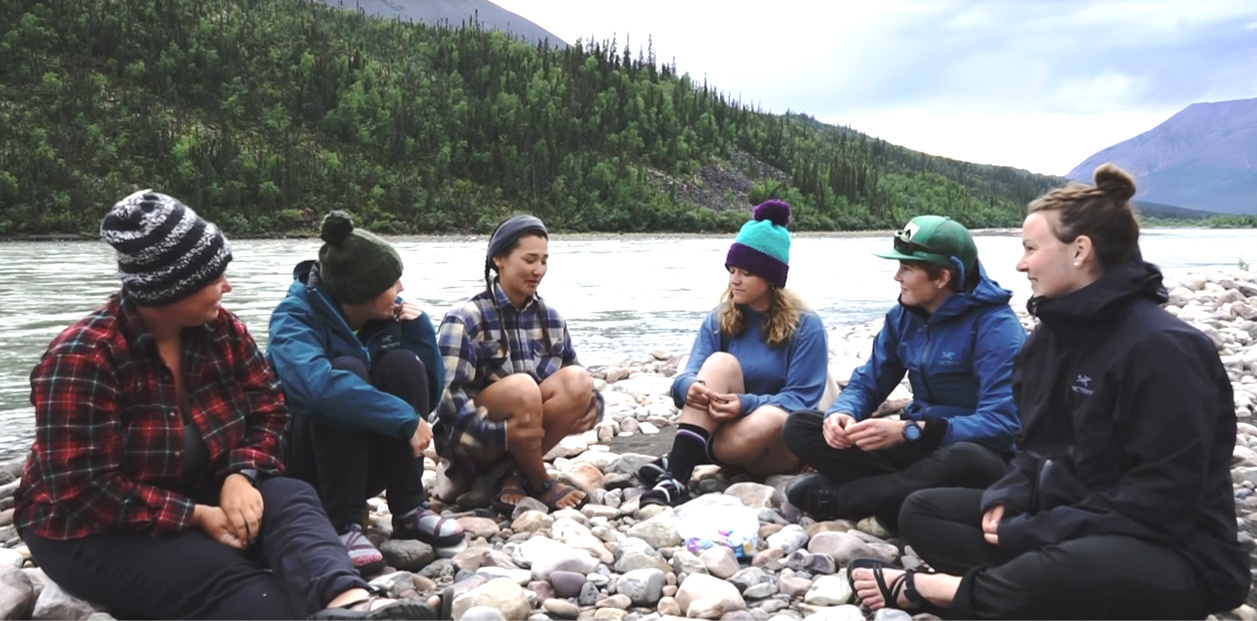
The cornerstone of our experience was gratitude, something we gleaned from our days on the water as camp counselors. The Grateful Circle was a camp tradition we brought with us on the expedition. Each night, no matter how late, or how buggy, we held our cherished circle and reflected on what we were grateful for that day. One day it could be as simple as that extra Jolly Rancher that got us through a long portage. Another day it was an invaluable piece of gear. Occasionally it was something more profound like finally relinquishing inhibitions, or having an illuminating, restorative conversation with our boat mate. Carrying on this tradition allowed us to connect with our sisters on the water elsewhere who were sharing what they were grateful for as they experienced the wilderness on their camp trips. This daily ritual offered a lens through which to see each day: with gratitude, intention and joy.

As the trip began, and the final beats of the prop plane grew faint, we stood on the banks of the Keele River in utter silence. Silence which was immediately disrupted with cheers, screams and exclamations of our excitement to finally be there.
We had been dreaming, researching, planning, packing, re-packing, and traveling toward this adventure for what seemed like forever. And then all of a sudden, after a hurried, wet, slightly panicked exit from the floatplane, we were in an epic wilderness we had only seen on maps or in pictures. And it was more awe-inspiring than we imagined. That moment literally took our breath away, put a hitch in our chests, and made our cheeks sore from constantly smiling.
Our elation at finally beginning what we set out to do was mixed with an overwhelming feeling of aloneness. We were about 250 miles from any type of civilization, and the only way forward was down the river. While the isolation obviously heightened our awareness and respect for the situation we were in, it was pure, uninhibited and majestic. That is why we sought, and continue to seek, wild places.

Our trip started deep in the Mackenzie Mountains, following the Keele’s winding curves and swift waters. Every turn delivered yet another striking mountain range, each cutting its own jagged outline across the sky. Steep, rugged peaks; clear, cold brooks streaming in from adjacent valleys; and a spectrum of colors and contrasts that complemented one another in a truly idyllic landscape— turquoise water, deep green forests, vibrant purple flowers, steely grey crags high above our heads, and tiger-striped rocks glimmering beneath our feet in the clear riverbed.
There was no shortage of joy and laughter as we ambled down the river, being swept easily along by the current. Filled with childlike wonder and giddy excitement at what this trip would hold, we explored every riverbank, cliff and cove along the way.
Though we breezed along at first, we knew it wouldn’t last. We stopped in the town of Tulita to pick up our lone batch of resupply food, which we’d sent ahead of us on a barge. The gracious hospitality provided by our hosts offered a welcome break, but we were anxious to begin the next section of our journey.



Once we reached the Great Bear River, we were forced to trek 75 miles upstream along its banks, tugging our boats behind us to eventually reach the Great Bear Lake. Determination, strength and unity enabled us to complete this section, something many people didn’t think we were capable of. Some thought the water would be too cold, others thought navigating up the rapids would be too dangerous, and the rest assumed we simply weren’t physically capable of enduring a 75-mile upstream slog. Yet every day we inched farther and farther forward. Each step a statement, and each mile gained proof not only to ourselves, but to those who questioned our abilities: we were up to the challenge.
The crux section of this river was an entire day of trudging up rapids, and along steep cliffs of loose rock, without a bit of flat land in sight to camp on. We couldn’t stop until we were out of the cliffs, we couldn’t cross to the other side of the river because the current and rapids were too strong, and we couldn’t take one wrong step on the slippery rock shelf we were navigating. Hours and hours went by in silence as we marched, but shaky legs and sore feet couldn’t taint our feelings of accomplishment once we made it to the end of such a crucial day.

Of course, this triumph and pride was felt throughout our entire journey, on that day especially, as the frigid water pushed against our legs, and the slippery boulders quaked beneath our feet, we reflected on how this physical resistance literally represented the battle many women are fighting in the outdoor industry. While women have been embarking on epic, outdoor adventures and achieving incredible feats along the way long before our time, it still feels like a sector dominated by men. We’re meant to feel weaker, to accept that we can’t handle harsh conditions—put simply, we’re no match for our male counterparts. Though our trip was just one example among many other female-led expeditions, each step we made up that river, and the steps and paddle strokes that followed, made us feel like we were doing our part in pushing against this societal resistance.
Even though the Great Bear River beat our bodies—and boots—each day with its rapids, mud, and cold rain and our progress was slow and laborious, we were rewarded by a sense of accomplishment and forward progress every evening. Smiles rarely faltered, sliding down a slippery slope was cause for hilarity rather than tears, and large muddy puddles under the tent were seen as a “waterbed-like feature” rather than a miserable campsite.
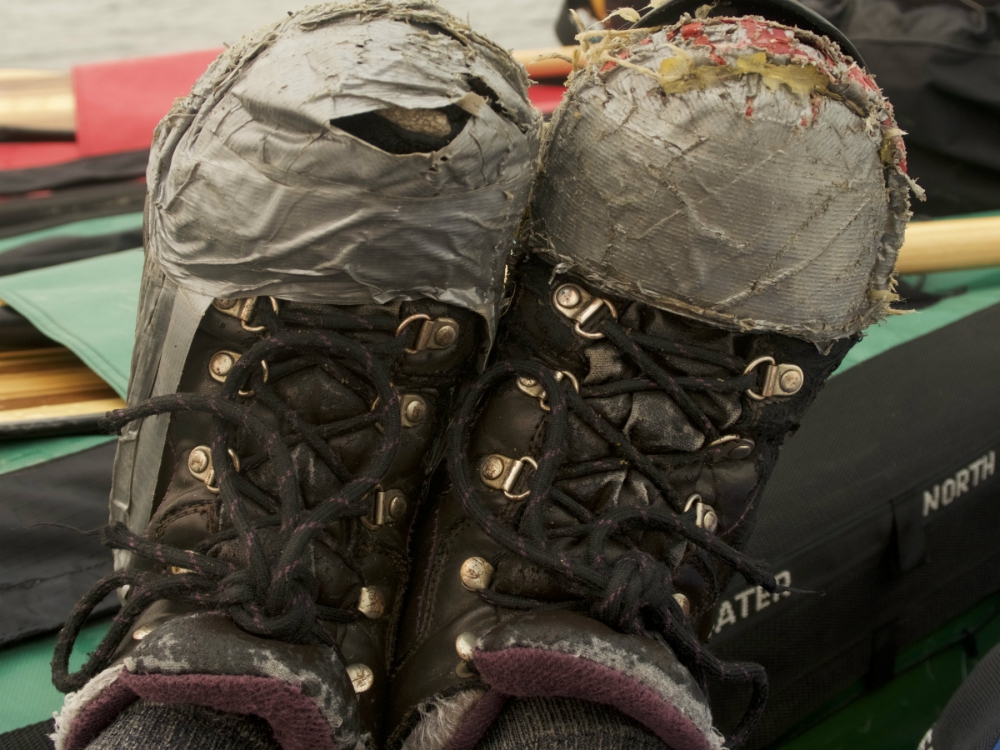


The beauty of the river valley led us through quiet forests that morphed into walls of snow and ice, before eventually opening into a wide mouth where the water met the sky in a blend of pale blues as we approached the Great Bear Lake.

Great Bear Lake is the eighth largest lake in the world. Our 250-mile crossing took us nearly three weeks. Before embarking on this section of our trip, we stopped for a two-day rest in the native community of Délįne. Our time with the Dene people was enriching and enlightening, an imperative experience before we launched across the lake. We were immersed in their culture, activities, and ways of life. This vibrant, unified community made more of an impression on us than we realized at the time.
One of the most instructive lessons we gained from the community was the legend of the water heart. A brilliant depiction of what Great Bear Lake means to its people. The legend describes Great Bear Lake as the source of all the water in the earth. A massive heart beating deep within its waters, sending life out through its veiny rivers to the rest of the world. This heart gives life to the lake and its beats can be both powerful and instructive. Something we found to be true as we paddled across. Learning humility daily, yet feeling held and supported in its gracious embrace.
Our time with the people of Délįne, and the wisdom they shared with us, distinctly shaped our journey forward into the vast waters of the Great Bear Lake.


Due to its size and ocean-like quality, Great Bear Lake is home to dangerous, daytime wind and waves. The lake was calmer and safer at night, so we chose to spend the next three weeks paddling from about 11PM to 6AM. Night paddling had its own set of risks—freezing temperatures, frosted lifejackets, and immovable fingers and toes. We had many an impromptu dance-party pit stop to force blood flow and attempt to warm up. Every calorie was coveted, and we thoroughly appreciated the thawing morning sun.
Despite the freezing temperatures, that beloved lake dazzled us daily with the most magnificent sunsets and rises we’d ever seen. It was impossible not to look up at the deep red sky, across to the pale lit moon, and down to the shimmering, still water and not feel completely alive.
Though transitioning our body clocks to night-time-living took a few groggy days to settle in, we fell in love with what the land of the midnight sun could offer. Wildlife was more active, colors more prominent, and the glassy water reflecting the magic of the sky rejuvenated our souls in a way the daytime couldn’t.
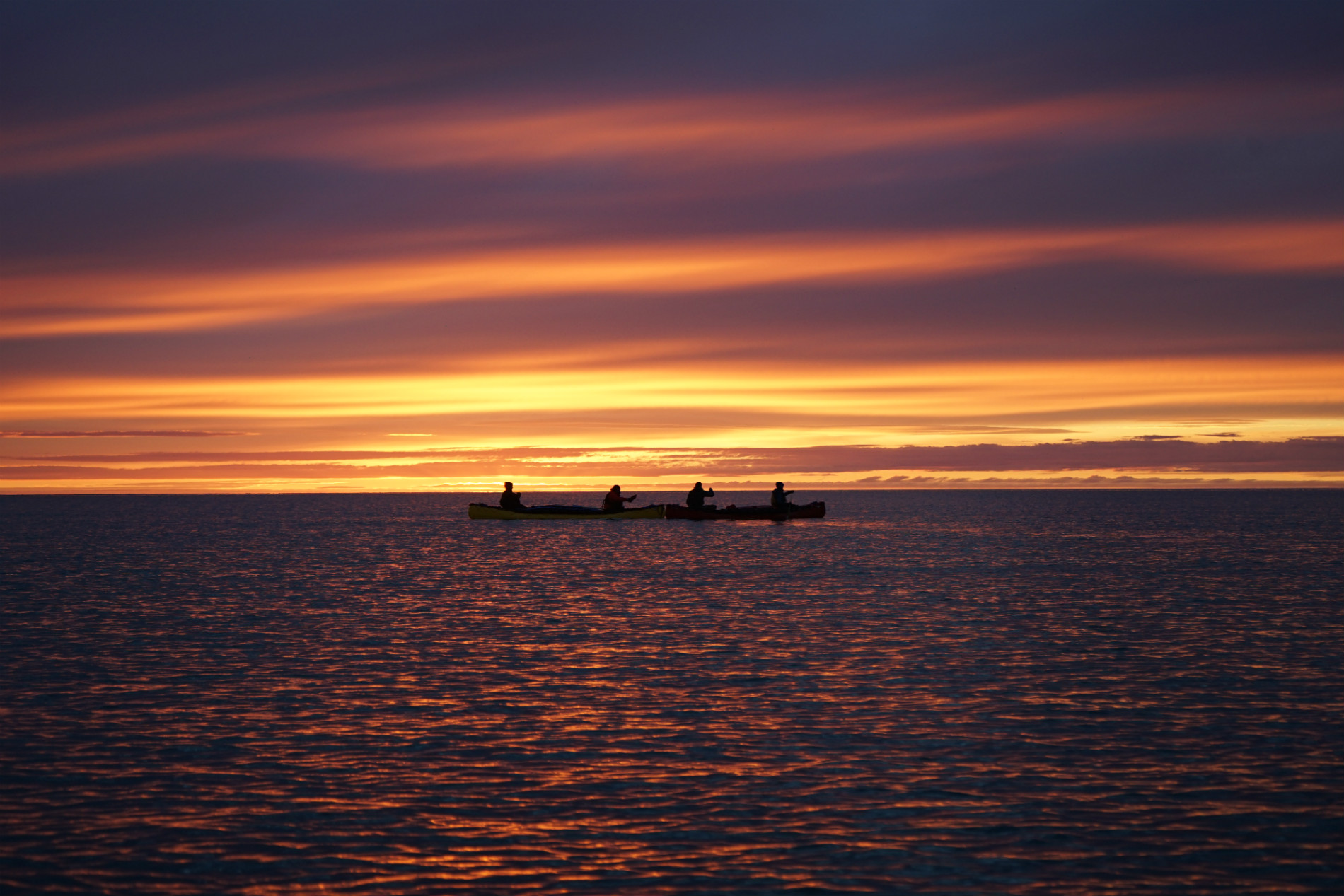
Sleep was still elusive, despite our exhaustion at the end of each paddle, as the sun rose to its full height and turned our tents into saunas. Some nights the wind and waves were still too risky, so we’d have a layover day, patiently waiting until we could paddle again. While we could have easily been frustrated that we weren’t making progress, and it was sometimes painful to keep ourselves awake all night in order to maintain our switched body-clocks, our layover days ended up being some of the most cherished times we shared together.
Passing the time took many wondrous forms: we crammed into one tent and took turns reading passages from our books to each other; we mimicked news anchors filming arctic birds competing for island dominance, built a smoking rack for our fish, attempted to capture the sunsets with watercolors; we held deep, restorative conversations and sometimes, we simply sat by the crackling fire for hours, watching the hues and tones of the sky change before our eyes.
We were blessed with protein aplenty as we reeled in enormous lake trout. Never mind the fact that these fish nearly tipped our boats at some points during the process; the slightly panicked cheers of “I’ve got one!” always left us with an exciting anecdote for the day and full bellies as we drifted to sleep.

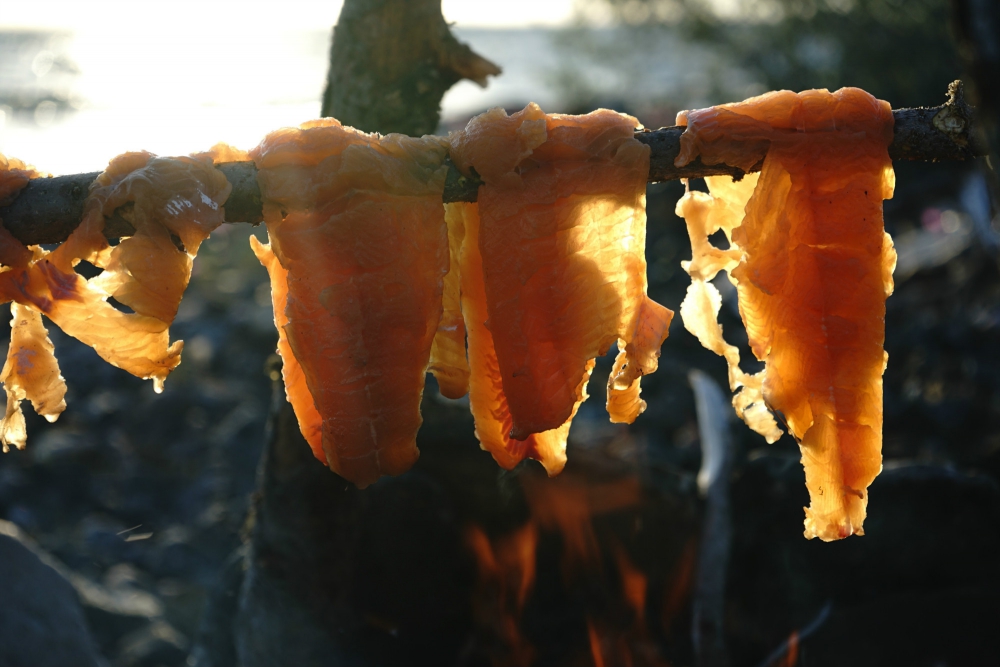

Our food rations were pre-planned and organized before we left for our trip with lots of easy meals like oatmeal, mac and cheese, and various kinds of soup. We broke up the monotony with more creative meals—hash browns and dehydrated eggs, pesto quesadillas, and personal pizzas—and we jazzed up every meal with our life-saving spice kit. Our food rations were sufficient for the majority of our expedition. However, as our daily progress became more and more physically demanding, our appetites grew accordingly. Each bite was more cherished, and each fish caught more appreciated. The generous lake providing just what we needed exactly when we needed it.

We exited Great Bear Lake with more joy and wisdom than we thought possible. The quality paddling time across the lake, and the trying trek up the river to get there, solidified our communication, trust, love and respect for each other. These qualities, along with our daily squat and abs regimen, would serve us well as we embarked upstream and over land once again to reach our next goal.
Though our previous jaunt upstream was a challenge, and slow going, it paled in comparison to what we faced next. This 60-mile section of our trip required hiking upstream on the Sloan River, then portaging across land, to finally descend the Hook River (more like the Hook Bed of Rocks), which led to the Coppermine River. Rocks were more slippery, trees were thicker, and navigating up rapids often took the majority of our group working together on one boat to ensure it didn’t flip or get lost downstream.
For example, if we reached a significant ledge, which we needed to pull the boat up and over, it required at least a team of three. One person slid into the river and sat on the ledge guiding the bow of the boat, keeping it close to shore. Another person pulled the rope attached to the bow from upriver to get it over the ledge. And the third pushed the stern of the boat out. Any errors and the boat would tip, or get turned around and wash away.

Bruises dotted our legs, blisters covered our feet, black flies invaded every crevasse…yet we perfected our portaging systems, picked each other up when we fell, and navigated the untouched landscape with reverence and respect. Never had we felt so remote and so vulnerable, yet empowered by the progress we were making.
Heavily laden with packs and canoes, we hopped from rock to rock, waded through swamps, and ducked under trees. At night, after we inhaled our dinner, and shared what we were grateful for, we dived into the tents with speed as the “witching hour” came and an apocalyptic amount of bugs descended. Giggling all the while as you heard the three girls in the other tent swatting away at the blackflies and mosquitos that managed to infiltrate. Drifting off to sleep, snuggling with rocks and trees roots, never felt so good.


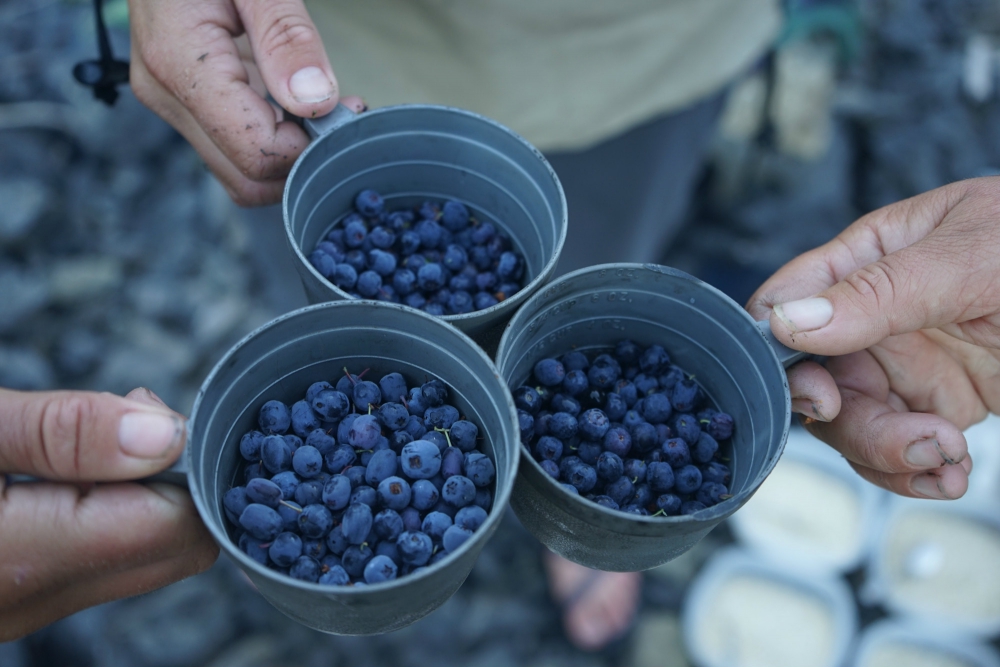
Though we had a goal in mind each day of how many miles we wanted to cover, it was never about just getting from A to B. Even on the toughest days, we still found joy in what we were doing. Stopping to collect blueberries became another daily ritual. We would sing, even when we were all lying on the ground exhausted between portaging trips. And treasured every last Snickers in our cache.
With all of our gear and boats, each portage was really three times the distance displayed on the map. On the first pass, one heavy load of gear was brought forward, each bag overloaded with whatever loose gear we could strap to it. Then we’d retrace our steps backward, often looking for an optimized route through the rough landscape. On the third trip, we’d bring forward the remaining bags and the three boats.

Even though it landed on our longest portage day (three 7km treks for a total of 21km), we took the time to celebrate Sammi’s birthday in style: We danced. We gave creative gifts made with our limited resources. (A hidden jar of Nutella even made an appearance.) The dinner party included a canoe table, place settings, wildflower centerpieces, birthday cake, and so much love shared for our sister. Though the Sloan/Hook challenged us mentally and physically, our support, encouragement, and admiration for each other only deepened, truly forging us into an unbreakable team.
As we emerged onto the Coppermine River, we felt both relief and sorrow. Getting back in the boats after so many days of walking was a dream, and the promise of the Coppermine’s legendary rapids and scenery awaited. Yet we knew this was the last leg of our trip, and it would go by too quickly.

The Coppermine’s reputation didn’t disappoint. Endless steep canyons lined the riverbanks, each rock face was a different color, topped with smooth, green tundra, and below a raging rapid for us to navigate. Anticipation turned to adrenaline, which turned into victorious cheers as we sped through each rapid. Reverence for the power of the river was our constant companion, as well as gratitude for safe travels in this wild land.

On our final day, as we emerged through the Coppermine delta into the Arctic Ocean, we were overcome with sudden fits of screaming and excitement followed by long moments of silence because we were genuinely speechless at the completion of our expedition.
On those last days we talked a lot about what success means. To the world success may mean just making it to the end of the route, or paddling 62 days without flipping the boat, or being able to run all the rapids. But we saw it differently. To us, success was found in experiencing joy every single day, living our lives fully and intentionally along the way, and being able to genuinely end every day with a message of gratitude.
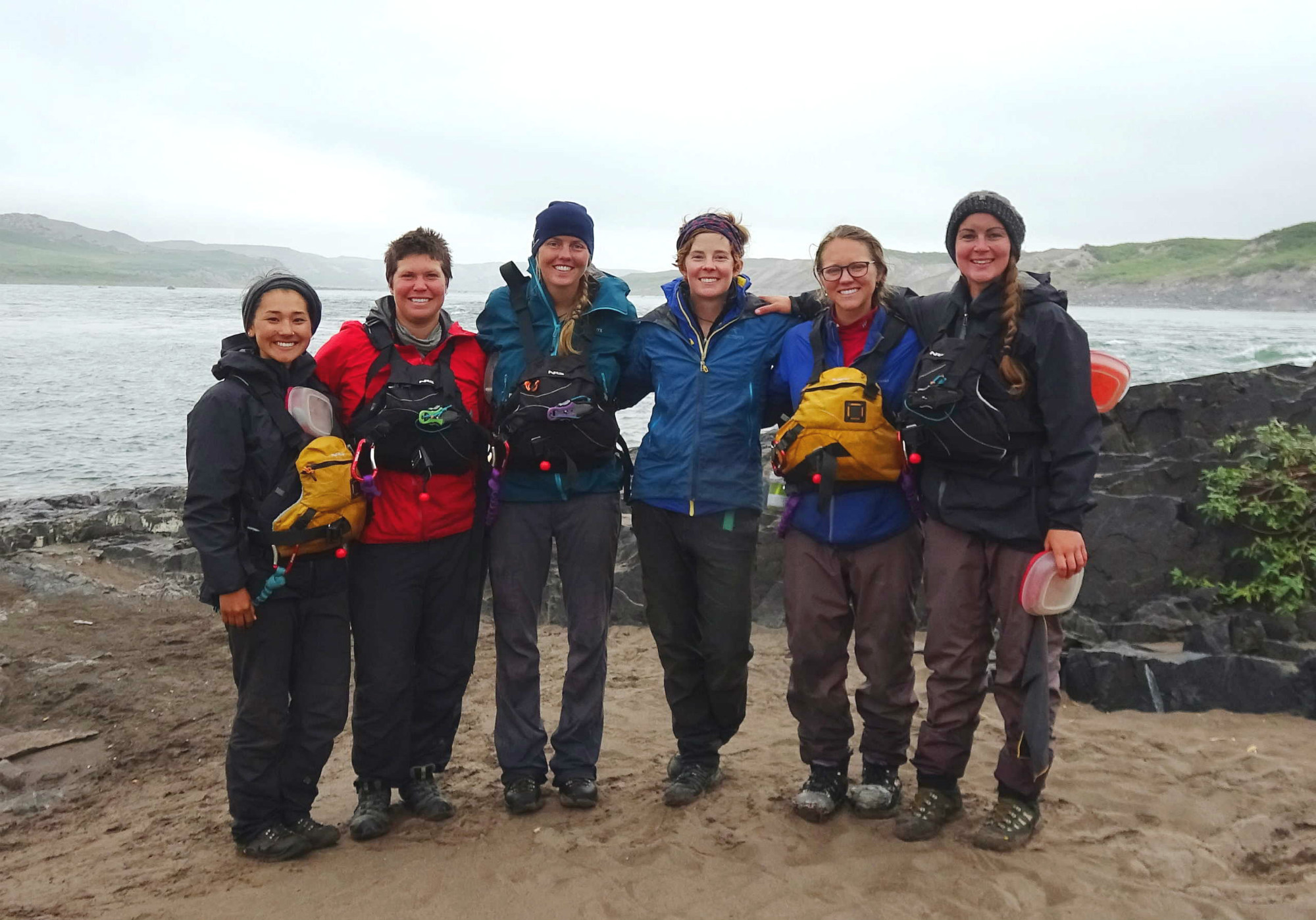
Editor’s Note: This was a collaborative piece created by the 6 North of 60 Team. Learn more about their collective mission to “paddle with purpose and tangibly empower and inspire girls, by helping them see that women are truly capable of anything,” at 6northof60.org.